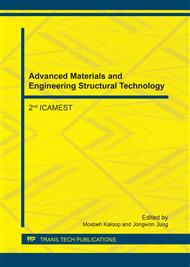p.133
p.142
p.147
p.157
p.162
p.167
p.173
p.179
p.184
Thermo-Micromechanical Vibration Behaviors of FGM Structures with Neutral Surface
Abstract:
This work presents the micro-mechanical models in thermal environment for the vibration behavior of Functionally Graded Materials (FGMs) plate using First-order Shear Deformation Theory (FSDT). In the formulation, the heat transfer effects and the temperature-dependent material properties are considered. Relative estimation of micromechanical behaviors of Mori-Tanaka Method (MTM) is used. And, neutral surface concept is adopted as the reference plane due to the asymmetry in the thickness direction of the model. In the numerical analysis, Finite Element Method is applied for various volume fractions and temperature rising conditions. Also Power-law and Sigmoid FGMs are discussed in thermo-elastic vibration characteristics.
Info:
Periodical:
Pages:
162-166
Citation:
Online since:
April 2017
Authors:
Price:
Сopyright:
© 2017 Trans Tech Publications Ltd. All Rights Reserved
Share:
Citation:


